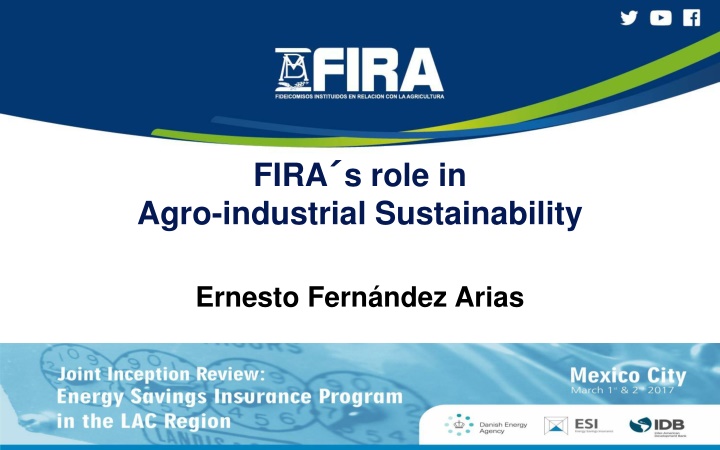
FIRA's Role in Agro-industrial Sustainability - Key Initiatives and Partnerships
Learn about FIRA's crucial role in promoting agro-industrial sustainability in Mexico through financing and support for sustainable projects. Discover the importance of funding sustainable initiatives in the agricultural sector due to climate change challenges. Explore FIRA's sustainable projects portfolio and collaboration efforts with international and national institutions for sustainable development.
Download Presentation

Please find below an Image/Link to download the presentation.
The content on the website is provided AS IS for your information and personal use only. It may not be sold, licensed, or shared on other websites without obtaining consent from the author. If you encounter any issues during the download, it is possible that the publisher has removed the file from their server.
You are allowed to download the files provided on this website for personal or commercial use, subject to the condition that they are used lawfully. All files are the property of their respective owners.
The content on the website is provided AS IS for your information and personal use only. It may not be sold, licensed, or shared on other websites without obtaining consent from the author.
E N D
Presentation Transcript
FIRA s role in Agro-industrial Sustainability Ernesto Fern ndez Arias
FIRA is a second tier financial institution. Its business model relies on 98 financial intermediaries from the banking and non-banking sector, as well as technological agents across the entire country. Technical Support to producers Training Technology transfer Internal capacity strengthening Funding Guarantees Intermediaries Financial Intermediaries Clients: agricultural producers receiving financing and technical support
Why do we need to finance sustainable projects? Agricultural sector contributes with 12% of the GHG inventory in M xico1/ Agriculture represents 70% of water consumption in Mexico Agricultural sector is greatly exposed to the (negative) effects of climate change. According to the INECC, it is expected in coming years to observe a rise in temperature between 2.5 C to 4.5 C, and a decrease in precipitation from 5 to 10%: Projected decreasing yields in crop production, particularly maize, in 2050 The rise of the sea level could affect agricultural lands by means of saline intrusion An increasing number and severity of tropical storms and natural disasters. Regarding oceans, a rise in temperature could collapse the fish stock colonies thus impacting on the productivity of fisheries. 1/ Inventario Nacional de Emisiones de Gases de Efecto Invernadero 2013 2/ INECC, Efectos del Cambio Clim tico en M xico, disponible en: http://iecc.inecc.gob.mx/efecto-cambio-climatico-en- mexico.php
Sustainable development, measures to alleviate climate change and programs targeting natural disasters assistance are public policies priorities in Mexico. Sustainable projects total finance portfolio (credit + guarantees) The sustainable projects portfolio of FIRA is mainly conformed by the following categories: Sustainable practices (e.g. no tilling techniques, greenhouse production, organic fertilizers), Efficient use of water (e.g. irrigation technologies), Renewable energy (e.g. PV projects), Energy biodigestors. $8,914 Nominal growth = 117% $8,202 $5,782 $7,545 $4,506 $4,100 efficiency, and 2013 2014 2015 2016 2017 2018 According to FIRA s institutional plan there is a sustainable projects Key Performance Indicator (KPI) that establishes a goal of credit portfolio of $8,914 million pesos in 2018. Avance Proyecci n Structure according to category of the sustainable portfolio Biodigestors, 2.1% This goal represents an increment of 117% of the sustainable credit portfolio in comparison to base year 2013 Forestry, 7.2% Efficient use of water, 25.8% Sustainable practices, 46.1% Energy Efficiency projects only contribute with 5.6% of the credit portfolio of sustainable projects, thus it is identified an opportunity area Energy Efficiency, 5.6% Renewable Energy, 13.1% 0% 20% 40% 60% 80% 100% * Parcial a Noviembre 2016
FIRA actively collaborate with international and national institutions to develop sustainable projects. Projects in cooperation with international actors: Actor: Programa de Eficiencia Energ tica (Energy Efficiency Program) Green Bond Manejo Forestal Sostenible (Sustainable Forestry) Programa de Apoyo a Proyectos Sostenibles (Sustainable Projects)
FIRA actively collaborate with international and national institutions to develop sustainable projects. Projects in cooperation with national actors: Actor: Programa de Eficiencia Energ tica (Energy Efficiency Program) Fondo Nacional Forestal / Plantaciones forestales comerciales (Commercial plantations) FONAGA Verde (Green guarantee scheme) Tecnificaci n de riego (Irrigation technologies) Bioseguridad pecuaria (Livestock biosecurity)
FIRA support productive projects and actions that contribute to implement the Climate Change y agricultural production Agenda The Agenda is the result of a joint effort of a diversity of organizations in the Mexican agricultural sector, and aims to produce climate friendly agricultural goods. Lines of action: 1. Sustainable livestock production Institutions coordinating the Agenda: 2. Sustainable fisheries and aquaculture 3. Sustainable agriculture 4. Sustainable forestry 5. Energy Efficiency 6. Renewable Energy
FIRA contributes with the Global Environment Facility (GEF) through the Project: Sustainable Productive Landscapes. The objective is to develop productive territories that promote the forest and jungles connectivity in order to preserve biodiversity and ecosystem services.
The Energy Efficiency Program of FIRA, as part of the ESI initiative, is an example of an innovative mechanism to foster climate change mitigation projects. In the ESI context, with support from the Danish Energy Agency, The Inter-American Development Bank (IDB), the Clean Technology Fund (CTF), and in cooperation with Secretar a de Energ a (SENER) and Comisi n Nacional para el Uso Eficiente de la Energ a (CONUEE), FIRA designed and developed an Energy Efficiency Program. The objective of the program is to foster the modernization of the agroindustry sector that contribute to increase its sustainability and productivity. The program incorporates as an innovative risk mitigation mechanism an Energy Savings Surety Bond (Fianza) It is expected that this model will be able to mobilize climate investments through market structuring and risk mitigation instruments that unlocks the agroindustry energy savings potential.
FIRA s role in Agro-industrial Sustainability Ernesto Fern ndez Arias











